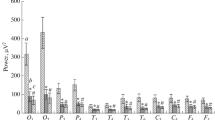Summary
Instead of a constant repetitive stimulation brain waves themselves were used to stimulate with the purpose to set the cortical excitation by light flashes in determinated wavesphases.
The relation between phase of the potential and resulting frequency of self-stimulation is investigated. If under due consideration of retinocortical time an excitation reaches the cortex 5–10 msec after the negative maximum of an α-wave, a saltatory frequency change from about 9 to 15 c/sec resulted. Furthermore the pattern is continuous till to the equivalent position of the following cycles. The point of saltation corresponds with the beginning of the supernormal phase of an evoked potential, suggesting the same kind of process as a basis of these phenomenons. The behaviour described was only exhibited by waves up to 16 c/sec. Reactions above 17 c/sec (β-waves) exhibited a different kind of distribution. They accumulated in a phase-segment with α-potentials of only slow frequency and exhibited no saltation of frequency.
This is considered to be a method leading to direct qualitative though restricted statements about the relationships between characteristic EEG-potentials and stimulation by sensory stimuli.
Similar content being viewed by others
Literatur
Bartley, H. S.: The relation between cortical responses to visual stimulation and changes in the alpha rhythm. J. exp. Psychol. 27, 624–639 (1940).
Kibbler, G. O., and D. Richter: Alpha rhythm and motor activity. Electroenceph. clin. Neurophysiol. 2, 227 (1950).
Kornmüller, A. E.: Einführung in die Klinische Elektrenkephalographie. München, Berlin: J. F. Lehmanns Verlag 1944.
Erregbarkeitssteuernde Elemente und Systeme des Nervensystems. Fortschr. Neurol. Psychiat. 8, 437–467 (1950).
Lansing, R. W.: Relation of brain and tremor rhythms to visual reaction time. Electroenceph. clin. Neurophysiol. 9, 497–504 (1957).
Monnier, M.: Retinal, cortical, and motor responses to photic stimulation in man: retino-cortical time and optomotor integration time. J. Neurophysiol. 15, 469–486 (1952).
Stamm, I. S.: On the relationship between reaction time to light and latence of blocking of the alpha rhythm. Electroenceph. clin. Neurophysiol. 4, 61–68 (1952).
Walter, W. G., and H. W. Shipton: The effect of synchronizing light and sound stimuli with varicus components of the electro-encephalogram. J. Physiol. (Lond.) 108, 50 (1949).
Author information
Authors and Affiliations
Additional information
Mit 2 Textabbildungen
Rights and permissions
About this article
Cite this article
Lux, D. Über kennzeichnende Unterschiede im Wert verschiedener Phasen typischer EEG-Potentiale des Menschen für die Aktivierung des EEG durch Augenbelichtungen. Pflügers Archiv 269, 489–494 (1959). https://doi.org/10.1007/BF00363033
Received:
Issue Date:
DOI: https://doi.org/10.1007/BF00363033




